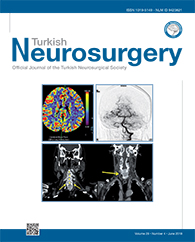MATERIAL and METHODS: Forty patients with thoracic myelopathy caused by OLF were studied retrospectively. The OLF was divided into fused and non-fused types according to the computed tomography and magnetic resonance imaging findings. All patients underwent posterior decompression. For the fused type, open-door laminectomy and for the non-fused type, French-door laminectomy surgical techniques were adopted. Preoperative, postoperative, and follow-up neurological conditions were evaluated using the modified Japanese Orthopaedic Association (mJOA) score.
RESULTS: The mean duration of symptoms was 9.2±11.5 and 8.4±9.7 months in the non-fused and fused groups, respectively. The apex of OLF at the most severely compressed level was located at 2.7±1.9 mm above the disc level: 2.4±1.6 and 3.0±2.2 mm in the non-fused and fused groups, respectively. The preoperative mJOA scores were 5.0±1.1 and 4.2±0.9 in the non-fused and fused groups, respectively. After the operation, the neurological deficits were improved in all patients. With an average follow-up of 33.9 months, the mJOA score was ultimately improved in both groups.
CONCLUSION: In OLF-induced thoracic myelopathy, the en-bloc elevation of the laminae with the OLF plaque is emphasized at the key site for surgical decompression. Based on the present classification of OLF, different surgical strategies should be adopted for a safe neurological decompression.
Keywords : Decompression, Laminectomy, Ossification of ligamentum flavum, Thoracic myelopathy, Thoracic spine




